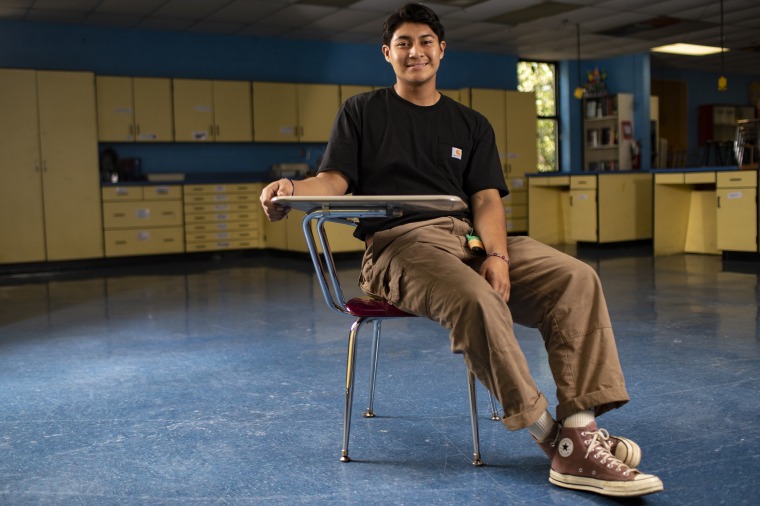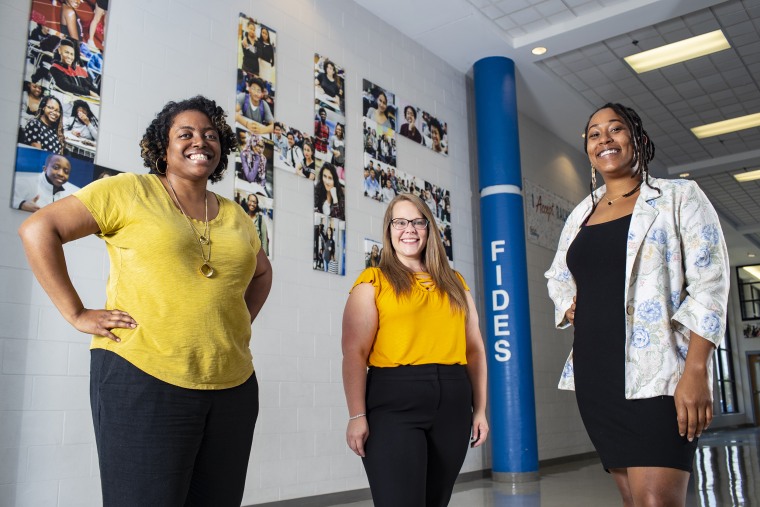This story about college enrollment decline was produced by The Hechinger Reporta nonprofit, independent news organization focused on inequality and innovation in education.
Even as freshmen nervously arrive on campus for the fall semester, policymakers are grappling with what they say has become an “alarming” decline in the number of high school graduates willing to invest the time and money it takes to go to college.
A little-understood backlash against higher education is driving an unprecedented decline in enrollment that experts now warn is likely to diminish people’s quality of life and the nation’s economic competitiveness, especially in places where the slide is most severe.
“With the exception of wartime, the United States has never been through a period of declining educational attainment like this,” said Michael Hicks, director of the Center for Business and Economic Research at Ball State University’s Miller College of Business.
There are 4 million fewer students in college now than there were 10 years ago, a falloff many observers blame on Covid-19, a dip in the number of Americans under 18 and a strong labor market that is sucking young people straight into the workforce.
But while the pandemic certainly made things worse, the downturn took hold well before it started. Demographics alone cannot explain the scale of this drop. And statistics belie the argument that recent high school graduates are getting jobs instead of going to college: Workforce participation for 16- to 24-year-olds is lower than it was before Covid hit, the Bureau of Labor Statistics, or BLS, reports.
Focus groups and public opinion surveys point to other, less easily solved reasons for the sharp downward trend. These include widespread and fast-growing skepticism about the value of a degree, impatience with the time it takes to get one, and costs that have finally exceeded many people’s ability or willingness to pay.
There has been a significant and steady drop nationwide in the proportion of high school graduates enrolling in college in the fall after they finish school — from a high of 70% in 2016 to 63% in 2020, the most recent year for which the figure is available, according to the National Center for Education Statistics.
The decline is even worse in some states, though not all have data for the same periods of time.
The proportion of high school graduates in Tennessee who are going directly to college, for example, has fallen to 53% — down 11 percentage points since 2017. In Indiana, it dropped to 53% in 2020, down 12 percentage points from five years earlier and a pace state Commissioner for Higher Education Chris Lowery has called “alarming.”
In West Virginia, 46% of 2021 high school graduates went on to college the following fall, 10 percentage points below that state’s high of 56% in 2010. Fifty-four percent of 2021 high school grads in Michigan went straight to college, down 11 percentage points from 2016.
In Arizona, 46% of high school graduates in 2020 went to college the following fall, a drop from more than 55% in 2017. In Alabama, recent high school graduates’ college-going in 2020 fell to 54%, down 11 percentage points since 2014. And in Idaho, college-going has plunged to 39%, down 11 percentage points since 2017.
Americans are increasingly dubious about the need to go to college. Fewer than 1 in 3 adults now say a degree is worth the cost, according to a survey by the nonprofit Strada Education Network, which conducts research into and financially supports ways of expanding access to higher education.
“That conversation has come up more frequently — ‘Is it worth it?’” said Jennifer Kline, a counselor at Festus High School in Festus, Missouri, a state where the proportion of high school graduates going straight to college is down by 6 percentage points since 2017, to 61%. “I just have more and more parents who are saying, ‘Nope. You’re not going to do that. You’re not going to a four-year college.’”
Her students’ parents “just don’t value education the way they did in the past,” said Amanda DeBord, an adviser in a statewide program in Tennessee called Advise TN. “I feel like that’s been slipping for a few years.”
One Advise TN student who is headed to college, Ever Balladares, said his classmates’ parents in the Nashville suburb of La Vergne used to tell them, “If you don’t go to college, you’re a bum.” That has changed, however. “They don’t think that anymore.”

This is being made only worse by a growing unhappiness among recent university and college graduates with the value of the education they received.
More than 4 in 10 bachelor’s degree holders under 45 don’t agree that the benefits of their educations exceeded the costs, according to a survey by the Federal Reserve. Only a quarter in another survey, by the educational publishing and technology company Cengage, said that, if they could do it again, they’d take the same educational path.
That adds up to a lot of bad reviews passed down to younger siblings and classmates, for whom family and friends are the most trustworthy sources about whether to go to college, according to a survey by the Indiana Commission for Higher Education.
Meanwhile, months of discussion about whether the Biden administration will forgive all or some student loan debt has had the unintended consequence of reminding prospective learners how many people before them had to borrow to pay for college.
So has the fact that many of their parents are still paying back their own student loans.
“There’s anti-elitism, anti-institutionalism, a perception that cost is out of control.”
Stephanie MarkeN gallup
From 2015 to 2019, Americans’ faith in higher education dropped more than their confidence in any other institution measured by the Gallup polling organization — an extraordinary erosion of trust, considering that this list includes the presidency, Congress, big business and the criminal justice system .
“There’s anti-elitism, anti-institutionalism, a perception that cost is out of control,” said Stephanie Marken, a partner in Gallup’s education division.
The problems have been evident for years, but colleges and universities in general have done little to address them.
They continue to advertise prices that few consumers actually pay but that discourage many from applying. They bury students in red tape, which is especially confounding for the increasing number of would-be applicants whose parents never went to college. And they often fail to make clear connections between academic disciplines and careers or keep up with the demands of the fast-moving labor market.
A degree does, in fact, still pay off. Workers with bachelor’s degrees earn 67% more than people with only high school diplomas, according to the BLS. More than half of “good jobs” — those with salaries of at least $35,000 for workers under age 45 and $45,000 for people 45 to 64 — call for bachelor’s degrees, the Georgetown University Center on Education and the Workforce estimates.
Yet since the start of the pandemic, the proportion of 14- to 18-year-olds who think education is necessary beyond high school has dropped from 60% to 45%, the nonprofit Educational Credit Management Corporation.
Even high school graduates who plan to go to college admit to doubts.

“My whole life has been sports, but at the same time it’s still, ‘Is college really for me?’” said Dillon Phillips, who played basketball at La Vergne High and hopes to go pro but will start at a community college to “ give me time to prepare” for a four-year university.
The pandemic only deepened the fears of students already struggling with self-confidence and skeptical about college, said Thea Cole, who also counsels students for Advise TN. “Their GPAs have suffered. So some of them are, ‘I don’t know if I can get in,’ or, ‘It will be too hard.’ ”Her colleague of her, Portia Cook, was more blunt:“ My kids have a shorter fuse. When things start getting complicated, they’re done.”
It’s not only recent high school graduates who are turning their backs on higher education. The number of Americans over 24 who are going for the first time or returning to college has also steadily declined, by 12% in the five years from the spring of 2017 to the just-ended spring semester.

Trying to get at the reasons so many people have stopped going to college, some states have conducted focus groups and surveys, revealing that the complexity of getting a higher education is to blame for some of the antipathy toward following through with it.
In Indiana, 70% of residents said they found trying to understand the state’s financial aid options “overwhelming.” In Tennessee, many high school students said they didn’t think they were eligible for state financial aid, even though they probably qualified.
“They especially don’t want to be told their life isn’t good enough. — ‘How dare you tell me what I need to do to make my life better.’”
charlee beasor, Indiana commission for higher education
Among the other findings of the Indiana Commission on Higher Education survey: Some Americans these days “balk at the idea of being told what to do by out-of-touch elites who don’t know them,” such as whether they should go to college.
“They especially don’t want to be told their life isn’t good enough. — ‘How dare you tell me what I need to do to make my life better,’” said Charlee Beasor, associate commissioner for marketing and communications at the Indiana Commission for Higher Education.
The growing disparities in college-going could widen the fissures already polarizing American society, Hicks said.
“Places like Los Angeles or DC or Chicago, they’re going to continue to draw a lot of college graduates,” he said. “For places that have a smaller share of college graduates, you’re going to have a more uncertain economic climate and lower wages.”
The United States has already fallen from second to 16th since 2000 among developed nations in the proportion of 25- to 34-year-olds with bachelor’s degrees. Countries ahead of it have increased their bachelor’s degree attainment during that time by an average of 177%, an analysis by an institute at the University of Pennsylvania found.
Even before the pandemic, the nation was facing a shortage of more than 9 million college-educated workers over the next decade, affecting nearly every state and costing nearly $1.2 trillion in lost economic output, the center-right American Action Forum estimated.
Economic rivals “could wish nothing better but to see the share of [American] adults who go to college drop by 12 percentage points,” Hicks said. “It is literally cataclysmic.”
